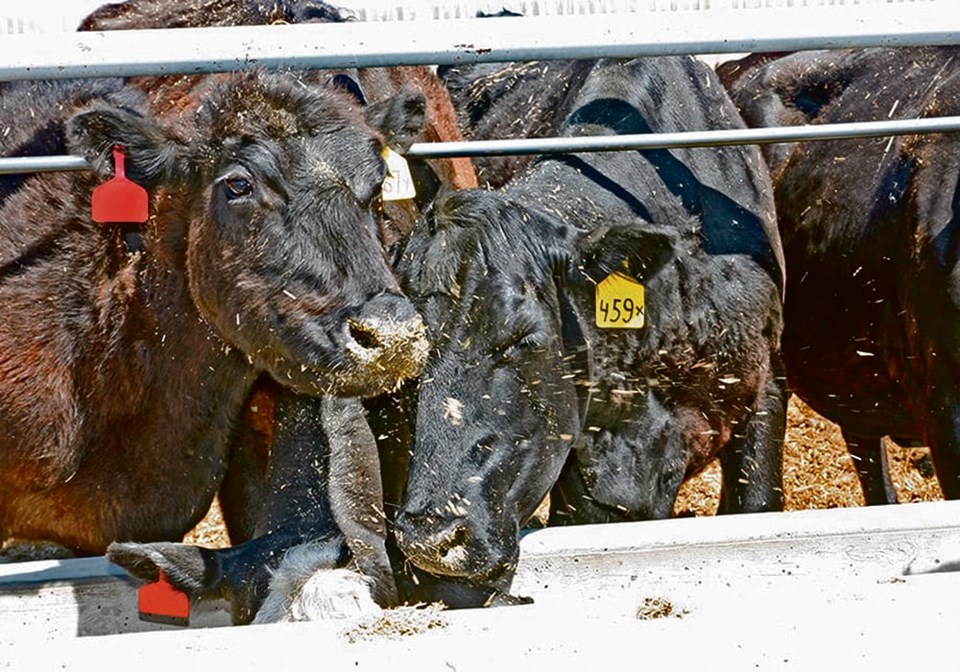WESTERN PRODUCER – New research from the University of Saskatchewan could lead to reduced days on feed for cattle in feedlots. The secret may be as simple as adding water to the ration.
Catherine Seidle, an animal science masters student, led the study and presented her findings May 15 at the Animal Nutrition Conference of Canada in Winnipeg.
Seidle’s goal was to get more even nutrient distribution at the feed bunk. Cattle tend to sort through the combination of high grain and low forage they’re given in a typical feedlot finishing ration and pick out the most appetizing bites. Competition between cattle means some animals get more than their share of one or the other feed type.
Water might fix the problem, Seidle figured. The hope was that adding moisture to the ration would bind feed ingredients and reduce sorting, with less expense or logistical hassle than other feed binders.
She chose barley for her study. Feed barley kernel size varies due to differing growing conditions and agronomic practices, she noted.
“In most cases, they’re blending heavyweight barley with lightweight barley to make it a more marketable midway barley. When that happens, the variability in kernel size is huge, and that barley is typically what’s going into our feed industry.”
The study tried to mimic as closely as possible the marketed feed barley. Because the grain is most commonly processed by dry rolling, Seidle did the same.
“When it goes through the dry rolling process, there could be two problems: overprocessing and underprocessing,” she said.
Larger kernels tend to get overprocessed, which results in an abundance of fine particles. Smaller kernels tend to be underprocessed, making them less digestible.
“Those fine particles are typically really fermentable, and when they’re really fermentable, that can cause an increased risk for digestive upset such as acidosis, which usually goes in conjunction with a reduced feed intake,” Seidle said. “So you have the worst of both worlds.”
When more dominant animals eat first and select the forage in the mix, it exacerbates the problem.
“This means that they’re eating a lower-energy-dense diet. And then the more submissive animals are going on to the bunk next, and they’re left with all of the fine particles, which means that they have a very high starch diet, which means that they probably have a higher risk for acidosis.”
Other than health concerns, the behaviour also adds variability in growth rates in that pen.
Producers often turn to binders like molasses, liquid whey or potato starch to address the problem, but there are purchase and storage costs associated with each, and they can also spoil.
“We just used plain old water,” said Seidle. “The water binds the ingredients together so that the small particles … are bound to the larger particles, and it limits the animal’s ability to sort the diet.”
Eight beef steers were fed four different dietary treatments that incorporated water at zero (control), 10, 20 and 30 per cent, relative to barley weight. The barley was aggressively processed to increase the number of fine particles.
“My hypothesis was that as we increase the amount of water in the (ration), there is going to be a decrease in the sorting potential of the diet, which means they’re going to be consuming more of those fine, rapidly fermentable particles,” Seidle said.
Results were encouraging. In the highest water treatment, unbinded fine particles were significantly reduced and cattle largely lost the ability to sort. There were also unexpected results. Wetter diets tended to increase dry matter intake.
“They actually ate more feed on a dry matter basis, and they drank more water,” said Seidle. “This is really encouraging for feedlots, because if they’re eating more, they’re gaining more, which probably means fewer days on feed, which in turn helps with cost.”
The expected relationship between fine particle consumption and high acidosis rates also bore out. A normal feedlot would likely not see the high levels of acidosis that were reported in her study, but the conditions of her study were extreme, Seidle acknowledged, pointing to the purposeful aggressive processing.




